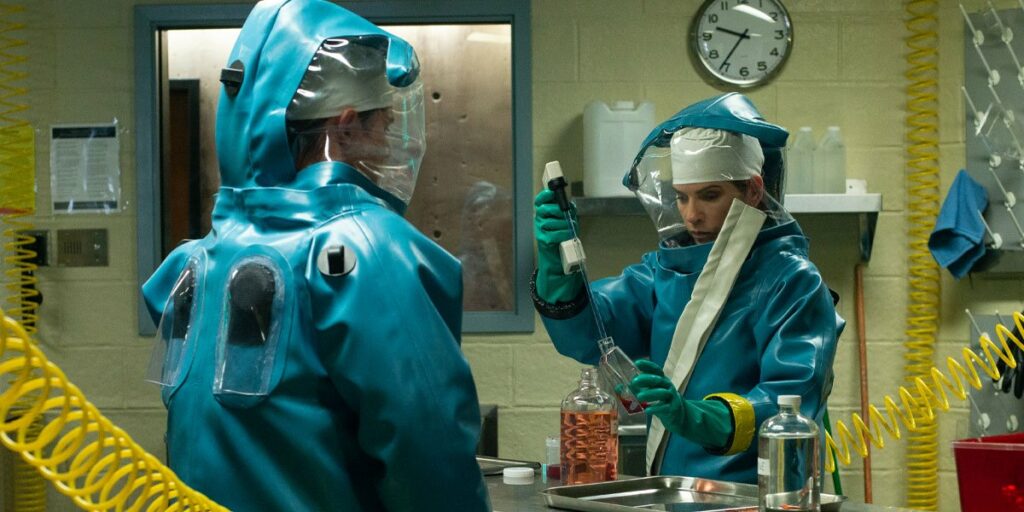The Hot Zone thrills and chills with visceral set pieces and a constant sense of danger and urgency, even if its dramatic elements don’t quite coalesce into a satisfying whole.
Nowadays, the word “Ebola” evokes startling terror, recalling the 2014 outbreak in West Africa where more than 11,000 lives were lost to the virus over a short period of just a couple years. Haunting images of doctors clad in yellow protective suits and nightmarish details of viral symptoms that dominated news cycles just a few years ago come to mind, familiar images again in a world experiencing an even more widespread pandemic. Less known, however, is the story of an earlier encounter with Ebola in 1989, when the virus first appeared on US soil and was eventually brought to the attention of the American government and scientific community.
Taking inspiration from Richard Preston’s 1994 bestselling nonfiction novel, National Geographic’s 2019 miniseries The Hot Zone dramatizes the story of this 1989 event with some artistic liberties. The six-episode series opens with a stomach-churning scene of a sick patient coughing up blood onboard an airplane and being taken to the hospital, introducing us to the horrifying symptoms of a deadly virus. Next, the action moves to USAMRIID (United States Army Medical Research Institute of Infectious Diseases), where a group of scientists, led by Colonel Nancy Jaax (Julianna Margulies) begins investigating the cause of death of a recent shipment of monkeys at a nearby facility in Reston, Virginia.
At first, they believe that SHF (Simian hemorrhagic fever) was the cause of death, but after testing the monkey samples in a high-tech laboratory, Jaax identifies Ebola-Zaire, a deadly virus that her mentor Wade Carter (Liam Cunningham) once encountered thirteen years ago. Faced with the resurgence of a deadly Ebola strain, Jaax calls upon the now-disgraced Carter to help prevent an outbreak in the nation’s capital.

The Hot Zone weaves between two narratives: the 1989 outbreak of Ebola in Virginia, and Carter’s 1976 expedition through Zaire. The flashbacks that appear in between scenes of the 1989 narrative are strategically-placed throughout the six episodes, offering sufficient background to establish Carter’s relationship to the Ebola virus and introduce his colleague Trevor Rhodes (James D’Arcy), who plays a more significant role in the later episodes. The flashback sequences continue even into the final episode, rounding out Carter’s character and answer our questions about him, without giving too much away earlier on.
Even though the series feels streamlined to craft a palatable narrative without delving too deeply into dense scientific detail, the six episode structure seems to stretch out the events of the story too far. It seems that the series is almost trying to draw out too much drama from such a small, contained series of events and perhaps this story would have been better told in a feature film rather than in a short television format. Often, several moments feel too dramatically convenient, exposing the fictional dimension to the story and threaten a sense of realism the series seems so intent on posing. Much of the quieter character moments feel like unnecessary padding, attempting to add a human dimension to the story, but instead come across as too flat with predictable dialogue and low-energy performances from the supporting cast, and those all feel like an afterthought to the more high-tension scenes featuring the main cast. Fortunately, the leading performances succeed, especially as Margulies commands Jaax with clear confidence and resolve and Cunningham gives Carter a silent and determined calculation.
Where The Hot Zone excels best are in its lengthy, riveting set pieces. The first episode “Arrival” features a sequence where Colonel Jaax and Captain Ormond (Lenny Platt) venture into the “hot zone,” or the Level 4 Biosafety laboratory at the USAMRIID facility to test the monkey samples and Jaax narrates the details of the decontamination procedure as they don their positive pressure suits. It’s a lengthy sequence, walking us through the complex stages of biosafety levels and dress procedures, deepening our immersion into the moment and building the anxiety and claustrophobia of being in a dangerous area while constrained inside protective gear. Meanwhile, a later scene involving an undercover mission inside an animal facility is captured like a horror film, with shots of darkened corridors, blinking lights, and the malevolent threat of violent monkeys, and the gripping payoff is more than worth all the lengthy buildup and preparation in a previous episode.
Despite its dramatic shortcomings, The Hot Zone is a riveting watch, thanks to a compelling sense of urgency throughout. Framing this story through a cinematic lens keeps us fully engaged and on the edge of our seats as it delivers thrilling momentum and a real sense of danger on the race to prevent an outbreak, even in a story we might already know the ending to. Most striking is the coda to the final episode, celebrating the efforts of the scientists to contain the outbreak and a call to action to be prepared and establish protocols for when the next viral outbreak occurs, not a matter of if, but a matter of when, because another one will arrive. Even though The Hot Zone premiered more than a year ago, this message, if familiar, is frighteningly prescient, making this series a potent and timely watch during quarantine.

